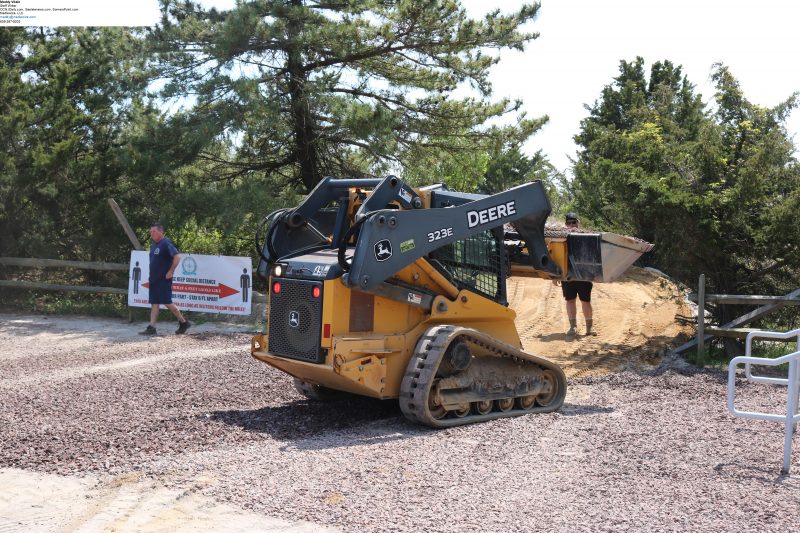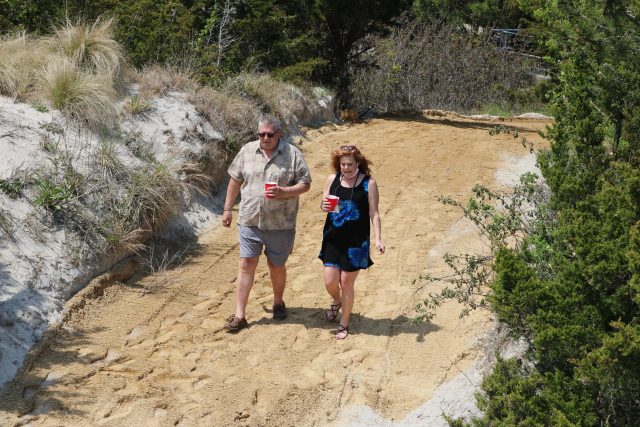
By DONALD WITTKOWSKI
Ironically, one of two pathways to the beach at Townsends Inlet Waterfront Park had too much sand, while the other has virtually no sand at all.
Sea Isle City’s Public Works Department used earthmoving equipment Wednesday to smooth out the pathway leading from the parking lot to the beach. It had too much sand, but is leveled out now to make it safer and easier for people to walk to the beach.
Meanwhile, the pathway that doesn’t have sand remains closed while Sea Isle officials decide what to do with it. Most of the sand there has been washed away, leaving a steep drop-off from the path to the beach. That pathway connects the waterfront park’s pavilion and boardwalk with the beach.
“They’re still assessing what can be done, if anything,” city spokeswoman Katherine Custer said of the possibility of repairing the damaged pathway. “It’s not an easy process when you’re dealing with the forces of nature.”
The sandy pathways were two of the areas that were radically altered earlier this month by the powerful waters of Townsends Inlet, the channel that separates Sea Isle and Avalon.
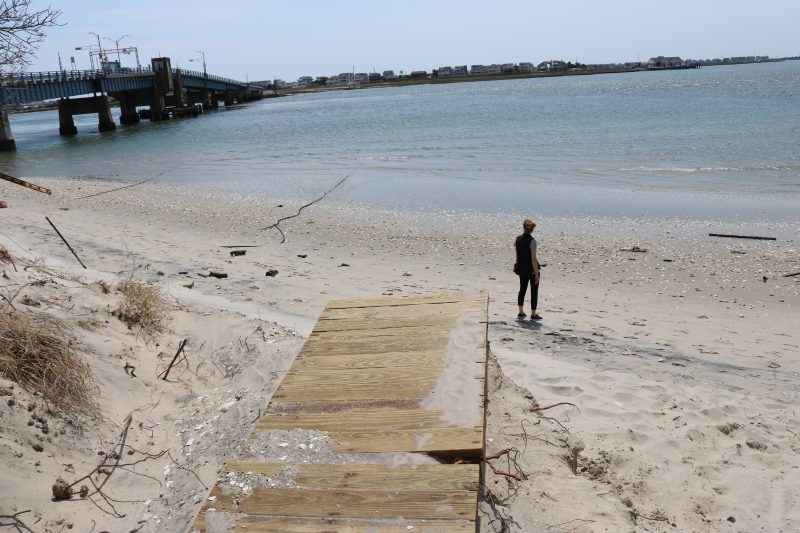
Part of the beach on the Sea Isle side of the Townsends Inlet Bridge was stripped of the top layer of powdery sand, leaving thousands of clam shells in its place. The remnants of the beach, in turn, have formed a gigantic sandbar that extends far into Townsends Inlet.
“Aside from the beach being small, there’s still plenty of sand for people in Townsends Inlet. It’s just not in the places where they would expect,” Custer said.
The massive sandbar juts far out into the inlet now, creating a makeshift beach for sunbathers and anglers to enjoy.
Although the sandbar extends into the inlet, it does not block boat traffic heading through the channel under the Townsends Inlet Bridge.
“The inlet is still navigable,” Custer noted.
Jason Pope, who drove from his home in Cherry Hill to do some fishing in Sea Isle on Wednesday, took advantage of the sandbar to try to catch some stripers.
“It’s pretty cool,” Pope said. “It allows us to fish here and get farther out in the channel.”
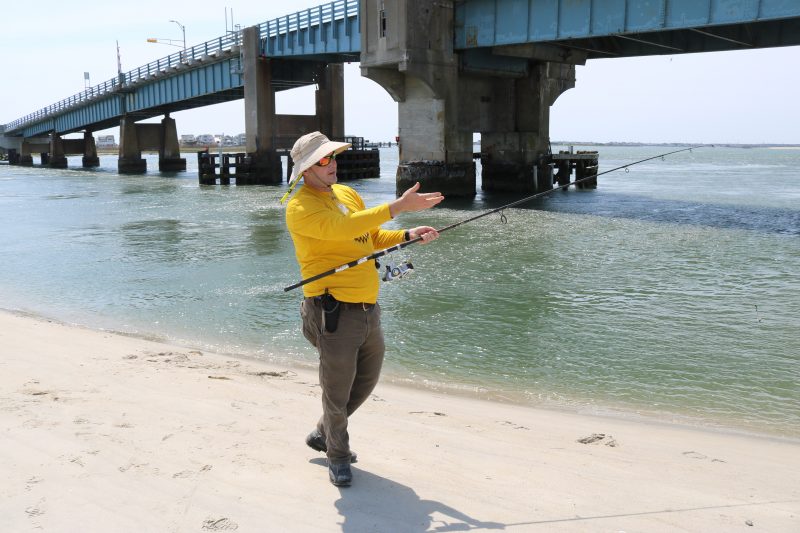
Pope, who was using bloodworms as bait, joked that all he was catching was “grass fish” as he reeled in a line filled with seaweed.
“It’s a slow day. But it’s better than work,” he said of the fishing.
Pope was struck by the dramatic contrast of the huge sandbar on the ocean side of the bridge and the nearly bare beach on the bay side.
“People have been coming to that beach for multiple generations. Now that piece of real estate is really small,” he said. “It’s going to be interesting to see what happens.”
Ultimately, Sea Isle may simply have to wait until the beach is returned to its former condition by Mother Nature.
“This is a natural environment. There are ever-changing environmental conditions,” Custer said.
This is not the first time that the beach on the Sea Isle side of the bridge has been abruptly reshaped by Townsends Inlet. Last summer, a large section of the beach south of 94th Street collapsed like a mini avalanche and was gobbled up by the water.
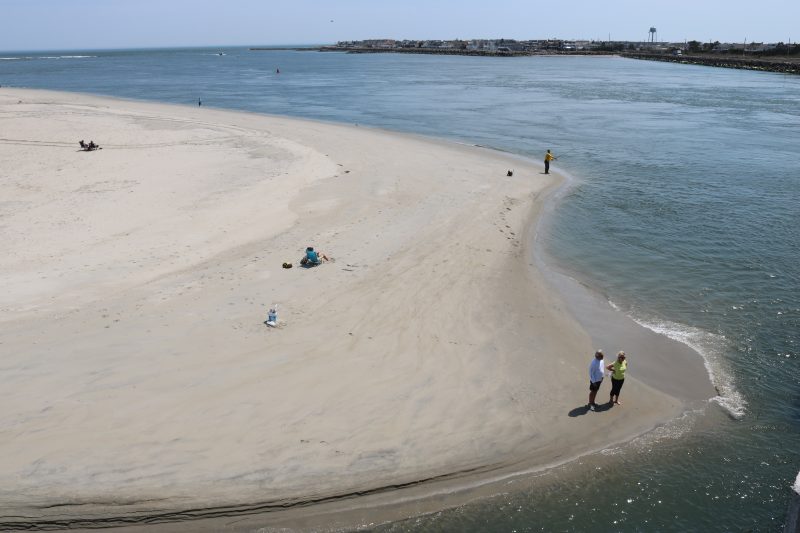
It is not clear whether a beach replenishment project may have had any role in the creation of the new sandbar. The U.S. Army Corps of Engineers, a federal agency, supervised the beach project in partnership with Sea Isle.
Last summer, Sea Isle’s beaches were widened and replenished with more than 750,000 cubic yards of new sand between 28th and 52nd streets in the midsection of town and from 74th to 93rd streets in Townsends Inlet at the southern tip of the island.
Steve Rochette, a spokesman for the Army Corps of Engineers, said the agency has no immediate plans to try to remove or reduce the size of the sandbar.
Generally, the Army Corps conducts annual surveys to monitor changes, trends and conditions with its dune and beach replenishment projects, Rochette explained. The agency frequency coordinates with the New Jersey Department of Environmental Protection’s Division of Coastal Engineering, the non-federal sponsor for the beach replenishment projects.
“In terms of the conditions at the southern end of Sea Isle City near Townsends Inlet, we use surveys to track longer-term trends, but there can certainly be significant seasonal variation and changes due to storms or other coastal phenomena,” Rochette said in an email.
